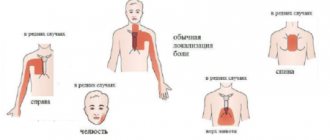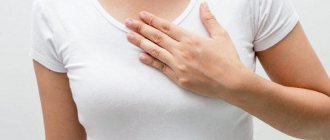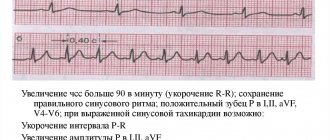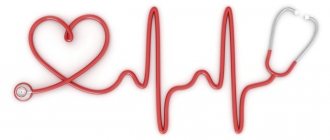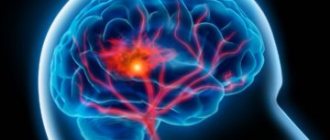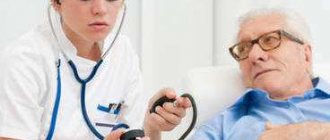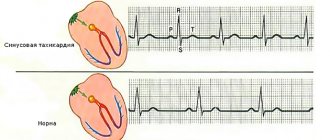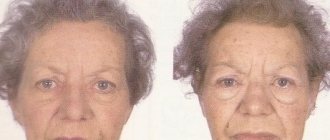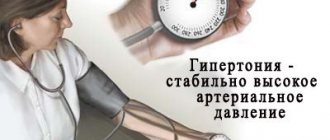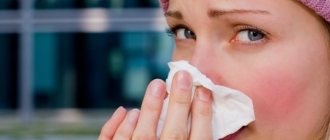How does the composition of cigarettes affect the heart?
Hundreds of thousands of people die every year due to smoking. The main component of cigarettes is nicotine. Just one cigarette smoked can shorten your life expectancy by several years.
Turning to world statistics, it becomes clear that smokers live 15-20 years less than people who do not abuse the bad habit.
People who smoke have impaired metabolism, blood circulation, and organs experience oxygen starvation. And the harmful effects are associated not only with nicotine, but also with other dangerous substances, which are abundant in the composition: heavy metals, indole, cadmium, acetone. It’s scary to imagine what the body is poisoned with every day.
After nicotine enters the circulatory system, a sharp release of adrenaline, that is, the stress hormone, is observed. The walls of the blood vessels instantly compress, the pressure rises, the heart rate increases several times - tachycardia occurs after smoking.
Nicotine and other substances in cigarettes negatively affect the functioning of the entire body. The heart muscle of a smoking person contracts up to 90 times in 30 seconds, which is not the norm. Due to the presence of oxidized carbon, the blood is no longer saturated with oxygen, resulting in oxygen starvation.
The rate of blood clotting increases and blood clots form. A suddenly detached blood clot is the cause of a heart attack or stroke. Nicotine suppresses the production of the hormone prostacyclin, which causes cell membranes to suffer.
Due to constant smoking, the level of bad cholesterol in the blood increases, and atherosclerotic plaques appear on the walls of blood vessels. This is the main cause of atherosclerosis and myocardial infarction.
A person who does not quit a bad habit in time may not only remain disabled due to the development of so many diseases, but may die.
Arrhythmia - a smoker's companion
Atrial fibrillation is the most common heart rhythm disorder on the planet. It occurs as a result of chaotic contraction of the atria. For some people, the rate may jump to 300 beats per minute. The Dutch decided to conduct research on this topic. They gathered 5,700 people over 55 years old. Based on the results of the study, it was concluded that not only current but also former smokers suffer from ectopic tachycardia. The research was carried out over 7 years.
Another scourge of smokers is extrasystole. This disease is characterized by sudden contractions of the heart muscle. A direct connection between nicotine intoxication and the appearance of tachycardia is also possible. As a result of the fact that most of the toxic substances enter the body, a person may experience heart failure and other cardiac pathologies. Almost all of them are accompanied by changes in heart rate.
Read also: Cardio loads for tachycardia
Smoking during an attack: dangerous or not?
Cigarettes are harmless only at first glance. Many do not take them seriously at all, perceiving them only as a source of smoke. In fact, smoking is dangerous, especially if at that moment there is an attack of tachycardia.
This is accompanied by the following symptoms:
- An increased pulse appears;
- Severe dizziness appears;
- Nausea, possible vomiting;
- There is a delay in breathing;
- Decreased performance.
If you already have cardiovascular disease, the situation gets worse during an attack. Gradually, the walls of blood vessels become less elastic, and their integrity is compromised.
The accumulation of nicotine in the body causes the lumen in the blood vessels to become blocked.
An attack of tachycardia can take you by surprise. Whether it is evening, night or day, ensure adequate air flow. To do this, go outside, open all the windows of the house, turn on the air conditioner.
How to get rid of it?
If the pulse is above 120 beats per minute, the person should immediately be given complete rest and first aid:
- The patient must take a deep breath and hold the air.
- You can press hard on the eyeballs.
- Wet the patient's face with very cold water.
- Drops of “Corvalol” and “Valocardin” help to reduce an attack.
You can forget about tachycardia only by quitting smoking. The rapid heartbeat goes away within just a few hours. Over time, a person will experience other positive changes in the body, but still a complete recovery does not occur after many years of smoking. However, the risk of various cardiovascular diseases is reduced.
Read also: Sinus tachycardia reviews
Will tachycardia stop if you quit smoking?
The form of tachycardia in heavy smokers is ectopic, sinus. The body will not be able to restore its full functioning until nicotine stops entering it.
Having given up smoking, a few days are enough for cleansing, however, due to the remaining habit, malfunctions may occur for some time, namely, tachycardia.
Due to the absence of chemicals in the body, the heart rhythm does not go astray, as it was before, but accelerates. It only takes one month for blood vessels to get rid of the toxins that have accumulated in them during smoking.
The self-healing process will begin. Due to the fact that cholesterol plaques will disappear, the load on the blood supply will decrease.
Quitting smoking improves the condition of the body as a whole: blood pressure is restored, the mouth stops drying out, there is no nausea or dizziness. Very little time will pass and you will forget about what tachycardia from smoking is.
Why experts do not advise smoking with arrhythmia
Arrhythmia of the heart muscle occurs due to the following factors:
- Reaction to stress factors, nerves, fear - the release of adrenaline “spurs” the heart muscle, which suddenly begins to contract faster;
- Lack of fluid - in the heat or after a long marathon, the body is dehydrated and tries to speed up the circulation of moisture to compensate for its lack;
- Sports stress – during active sports, the heart rate increases;
- Gluttony - blood constantly rushes to the stomach, so the body tries to maintain standard blood circulation due to an increased heart rate;
- Stimulants (alcoholic drinks, caffeine, energy drinks, drugs);
- Tobacco smoking – due to stimulation of the body by nicotine;
- The woman is pregnant.
Smokers are characterized by 2 types of arrhythmia:
If the disease is tachycardia, the harm from tobacco is obvious. Smoking significantly aggravates the situation by reducing the supply of oxygen to the blood due to carbon monoxide. The resulting heart failure with an accelerated heart rate is a serious risk to life.
What happens in the body after quitting smoking
Quitting smoking means completely restoring your health. Many processes that started at the moment of addiction to an addiction are reversible. But for the body to fully recover, it will take not one, two, or even three years. The stage is long, up to ten years.
Despite many changes, it is not always possible to see them with the naked eye, because they are not only external, but also internal:
- Reduced blood pressure;
- Cleansing and strengthening the walls of blood vessels;
- Restoration of the bronchi, cleansing of accumulated sputum;
- Increased life expectancy;
- Restoring the sense of smell and taste buds.
This is not a complete list of what happens after giving up a bad habit.
The main question that interests women is whether their appearance will change after they return to a healthy lifestyle. The answer is yes.
Moreover, the first changes can be assessed after a few weeks. The face acquires a healthy color, the color of the teeth is restored, a pleasant smell from the mouth appears, the color of the nails changes, and the hair structure is strengthened.
If you previously had problems conceiving a child, they will most likely go away too. After quitting smoking, hormonal levels are restored, and the likelihood of conceiving a child and bearing it completely healthy increases.
In men who have given up their habit, erections improve, the duration of sexual intercourse increases, and the quality of seminal fluid improves.
What to do if you can't quit smoking
To smoke or not to smoke is the choice of every sane person. However, even if you decide to quit doing this once and for all, many difficulties may arise. At first glance, it seems that there is nothing complicated and throwing away a cigarette is as easy as taking it, but this is not so.
Without realizing it, smokers find themselves in the grip of psychological addiction. To support your body and prevent it from “falling apart” ahead of time, you should follow simple rules:
- Pay attention to your diet, exclude foods that stimulate cholesterol production.
- Fill your body with fruits and vegetables, foods rich in potassium and magnesium.
- Caffeine is strictly contraindicated.
- Taking the pharmaceutical drug Ascorutin is useful.
- Try not to smoke in the morning and before bed.
- Walk outdoors more often.
- In the morning after sleep, do exercises. A set of exercises will restore blood flow and saturate the blood with oxygen.
- Visit the hospital at least once a year for preventive examinations.
Tachycardia in smokers develops over time. And if a person thinks that this fate will bypass him, he is deeply mistaken. Therefore, before you start smoking, think about what is more important – health or comfort.
Atrial fibrillation: description, causes, symptoms, danger and treatment
What it is
Normal functioning of the heart muscle is the contraction of the atria and ventricles in the correct sequence. When there are disturbances, the heart begins to contract in the wrong rhythm, so the medical name for this phenomenon is arrhythmia.
The most common type of disease in people is atrial fibrillation. In this case, the phase in which the atria contract disappears in the work of the heart muscle. Instead of contractions, twitching or “flickering” occurs, which affects the functioning of the ventricles.
Prevalence
The disease has been known for quite some time, and according to statistics, every two hundredth visitor to the clinic is diagnosed with heart rhythm disturbances.
Often, atrial fibrillation (AF) appears as a consequence and complication of coronary artery disease or hypertension.
AF includes both atrial flutter and fibrillation.
Various studies of this disease have been carried out in the UK and USA, which show that this disease occurs in 0.4 - 0.9% of the adult population.
An attack of AF is usually pronounced at the beginning, then relapses begin to occur (periodic ejection of blood into the aorta).
Classification, differences between species, stages
The disease has 3 stages:
- Stops without any treatment. It does not pose any particular danger and has a favorable prognosis.
- Doesn't stop on its own. Heart rhythm is restored due to medication or physiotherapy.
- Constant. There is a need to constantly monitor heart function to avoid thromboembolism.
Atrial fibrillation can be paroxysmal (paroxysmal) and permanent (long-term); the treatment for both forms is similar.
Why it occurs, risk factors in young and elderly people
Most often, this disease of the heart muscle occurs as a result of rheumatic damage, as well as obesity or diabetes (mellitus), myocardial infarction (find out what it is and what the consequences are), and alcohol damage.
It affects the heart muscle and taking various medications, smoking, strong psycho-emotional stress, frequent consumption of caffeinated drinks - coffee, strong tea, energy drinks.
Heart surgeries and congenital heart defects can also be considered risk factors.
Our readers successfully use ReCardio to treat hypertension. Seeing how popular this product is, we decided to bring it to your attention. Read more here...
Most episodes of MA disease occur in elderly patients—over 75 years of age. Not everyone can accurately determine the cause of this disease.
Cardiac pathology is one of the most common causes. This disease often occurs if the patient has ever been diagnosed with diseases or disorders of the thyroid gland.
A risk factor for young people is bad habits. Drinking alcohol in unlimited quantities and smoking greatly increase the likelihood of developing MA.
Symptoms and signs of an attack
How does arrhythmia manifest? This depends on the form in which the disease occurs, as well as on the characteristics of the person’s psyche and the general condition of the myocardium.
The initial signs of this heart disease include periodic shortness of breath, which does not stop for a long time after playing sports, rapid heartbeat, pain or other unpleasant sensations. All this occurs in the form of attacks.
Not everyone develops the disease into a chronic form. Seizures may begin and recur occasionally throughout life. In some patients, 2 or 3 attacks of atrial fibrillation become chronic. Sometimes the disease is detected only after a thorough medical examination.
Learn more about this disease from this useful video:
Diagnostics
To make a correct diagnosis of heart muscle disease, the following diagnosis is carried out: the patient is asked to perform some physical exercise, then an ECG procedure is used.
If the form is bradysystolic, then when the muscles are loaded, the rhythm increases greatly. Differential diagnosis is often carried out with sinus tachycardia.
Signs of atrial fibrillation on the ECG:
First and emergency aid for paroxysm
To avoid attacks, remember to take medications prescribed by your doctor to calm your heart rate.
The first thing you can do to help yourself or others during an attack of atrial fibrillation is to call an ambulance. If this often happens to you personally, carry the pills prescribed by your doctor with you. Usually these are valerian tablets, validol or volocardin.
If the place is crowded, then ask those around you if they have medicine. If the pressure drops sharply, the lungs begin to swell, and a state of shock occurs.
What can be done, treatment tactics, medications
How to treat atrial fibrillation? First of all, it depends on the form of the disease. Treatment of atrial fibrillation can be medicinal and surgical (operative).
The main goal is to restore and maintain sinus rhythm, control the heart rate and avoid thromboembolic complications after illness.
One of the most effective means is the administration of novocainamide, as well as cordarone or quinidine, into a vein or inside.
Propanorm is also prescribed, but before this you should monitor your blood pressure and monitor the electrocardiogram readings.
There are less effective medications. These most often include anaprilin, digoxin or verapamil. They help get rid of shortness of breath and weakness in the body and rapid heartbeat.
You can see how electrical cardioversion is performed for atrial fibrillation in the video (in English):
If MA lasts more than two days, then the patient is prescribed warfarin. This drug prevents the development of thromboembolic complications in the future.
The most important thing is to treat the underlying disease that led to heart rhythm disturbances.
There is also a method that allows you to eliminate atrial fibrillation in a radical way. This is radiofrequency isolation of the pulmonary veins. In 60% of cases the method helps.
Sometimes traditional treatments help. These include taking a decoction of hawthorn and valerian.
Rehabilitation
When the attacks of arrhythmia are removed, the heart function is restored and the patient is allowed to go home, it is necessary to undergo rehabilitation, which includes a full range of preventive measures.
The first thing you should pay attention to in case of atrial fibrillation is adjusting the nutritional system and maintaining a diet. You should try to minimize your intake of saturated fats, such as butter, and salt.
A heart patient needs foods that contain a lot of potassium, and salt is an antagonist.
You need to include in your daily diet not only bananas, which contain a lot of potassium, but also foods such as baked potatoes, dried apricots, blueberries, and apricots.
To reduce the negative impact of a respiratory arrhythmia, you need to pay attention to your breathing. Difficulty breathing worsens the general condition, as a result of which the body becomes oversaturated with carbon dioxide. To normalize the respiratory vessels, you should try breathing according to the Buteyko system.
Find out how to breathe correctly using the Buteyko system from the video:
Proper breathing allows you to avoid vascular spasms and is an excellent prevention of atrial fibrillation. Many patients benefit greatly from walking as a form of rehabilitation.
Possible complications from smoking with tachycardia
A smoker sooner or later hears the diagnosis of tachycardia. It may take a month, a year or even two from the moment the habit begins to be abused.
In the future, complications will be more serious:
- High pulse - frequent attacks of increased heart rate are fraught in the future with more serious problems with the heart rhythm and the occurrence of severe arrhythmias;
- Stroke;
- Heart attack;
- Pulmonary edema;
- Fainting, the frequency of which is constantly increasing;
- Thrombosis of blood vessels;
- Sudden cardiac arrest.
By continuing to smoke, knowing about the harm to your health, you are dooming yourself to suffering.
No doctor can say when this or that complication will happen, but the fact that it will happen is a fact.
Electronic cigarettes and hookah
It is difficult to find a person who would not like to get together with friends and sit in a hookah bar. And if everyone knows about the dangers of cigarettes on health, then hookah is considered completely safe. And indeed, even nicotine is not always used as a refueling. In fact, the degree of its danger is underestimated by many.
A person who smokes does not feel any discomfort, and all because they are minimal. However, the more often a hookah or e-cigarette is smoked, the greater the harmful effects. Sooner or later, symptoms of tachycardia will appear, leading to complications that have already been described above.
The tobacco that goes into a hookah contains several substances:
- Glycerol;
- Unnatural preservatives;
- Flavors;
- Marinade.
Only electronic cigarettes have a stronger effect on the cardiovascular system than hookah. They, just like regular cigarettes, contain nicotine.
There are other substances that are hazardous to health. They enter the body even when inhaling smoke, which means that a passive smoker can also suffer:
- The dyes in the composition of the electronic cigarette give the liquid bright, rich colors. Their entry into the body provokes disruption of both ventricles of the heart.
- Flavorings – add taste and smell. Few people know, but they thicken the blood.
- Purified water is a kind of solvent that allows you to give the liquid the desired viscosity.
- Glycerin – makes the steam aromatic. Promotes narrowing of valves and blood vessels.
Whatever you smoke, hookah, cigarettes, electronic cigarettes, all this poses a great danger to your health. Therefore, before you take anything into your hands, think several times!

